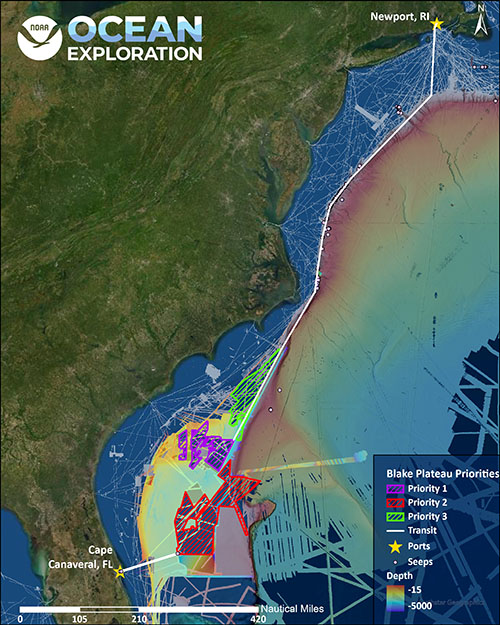
August 16 - September 30, 2021
From August 15 to September 28, NOAA Ocean Exploration will conduct two telepresence-enabled exploratory ocean mapping expeditions on NOAA Ship Okeanos Explorer. The first expedition will depart from Newport, Rhode Island, on August 16 and arrive in Port Canaveral, Florida, on September 2. The second expedition will depart from Port Canaveral on September 5 and return to Port Canaveral on September 28. These expeditions will include 24-hour-a-day acoustic exploration mapping operations in areas generally deeper than 200 meters (656 feet) in U.S. waters off the east coast, with a focus on the Blake Plateau.
The first four days of the first expedition will consist of a transit from Rhode Island to the primary mapping grounds, with a strategically planned trackline aimed at collecting data over several seeps previously discovered by NOAA Ocean Exploration along the edge of the continental shelf. Following this initial transit, the remainder of the expedition will focus on conducting systematic ocean mapping operations on the Blake Plateau region in U.S. waters offshore of North Carolina and Florida.
NOAA Ocean Exploration and partners have conducted focused expeditions on the Blake Plateau region off the southeastern U.S. coast for the past several years. These efforts have documented the most extensive continuous cold-water coral mound reef ecosystem yet discovered in the world and have provided high-resolution imagery of the seafloor as well acoustic backscatter information about the seabed and water column. With these upcoming expeditions, NOAA Ocean Exploration and partners from the U.S. Geological Survey and the Bureau of Ocean Energy Management hope to complete mapping of the deepwater ( greater than 200 meters/656 feet) portions of the Blake Plateau and to identify dive sites for future remotely operated vehicle operations.
These expeditions support the National Strategy for Mapping, Exploring and Characterizing the United States Exclusive Economic Zone (pdf) and Seabed 2030 and will contribute to the Atlantic Seafloor Partnership for Integrated Research and Exploration (ASPIRE) in support of the Galway Statement on Atlantic Ocean Cooperation (pdf).

Figure 1: Map showing the general operating area for the 2021 U.S. Blake Plateau Mapping expeditions. Areas will be addressed in order of priority, depending upon environmental conditions. Image courtesy of NOAA Ocean Exploration. Download largest version (jpg, 4.3 MB).
In addition to the standard exploratory mapping procedures, these expeditions will aim to further evaluate the efficacy of using a shore-based team of geographically dispersed seafloor mapping experts and explorers-in-training for multibeam sonar data processing via internet-based cloud services. Shore-based personnel will work closely with the at-sea mission team to streamline these cloud computing capabilities, potentially enhancing current telemapping capabilities.
Engaging and training the next generation of ocean explorers is an important mission goal of NOAA Ocean Exploration. This expedition will be the first aboard NOAA Ship Okeanos Explorer in which interns enrolled in the Explorer-in-Training Program have the option to participate either at sea assisting in data collection, or on land supporting data processing via internet-based cloud services. This program is open to enrolled undergraduate and graduate marine science students as well as those who have recently graduated from a higher education program. Joining the mission team on a NOAA Ocean Exploration expedition is a unique and highly competitive early-career opportunity, and the individuals selected for these expeditions will obtain exceptional hands-on experience in cloud computing, ocean exploration, at-sea research operations, and ocean mapping technology.
During both expeditions, NOAA Ocean Exploration will share expedition news on social media and its website. Exploratory missions like this are necessary to expand our knowledge of unknown and poorly known deepwater areas and to provide data for decision-makers. All data collected on this expedition will be available in NOAA’s public data archives within 60-90 days of the conclusion of the cruise and accessible via the NOAA Ocean Exploration Digital Atlas.
Published August 12, 2021